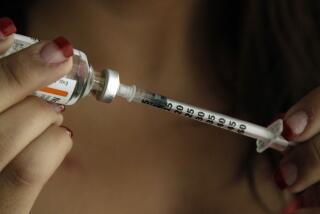Proper Care Can Reduce Many Complications for Diabetics
- Share via
D iabetes is the fourth leading cause of death from disease in the United States. But, according to the American Diabetes Assn. , about half of the 14 million Americans who have it don’t even know it.
What is diabetes?
Diabetes occurs when the pancreas doesn’t produce enough, or any, insulin, the hormone that helps glucose become absorbed into the cells for energy and into the liver and fat cells for storage.
If there isn’t enough insulin, the level of glucose in the blood becomes too high, causing the sufferer to urinate frequently, feel constantly thirsty and hungry and have blurry vision from time to time. Because the body can’t store the glucose, the diabetic begins to lose weight and feel tired.
The Statistics:
* Diabetes is the leading cause of blindness in people ages 25-74.
* Diabetes is the most frequent cause of amputations of lower limbs, aside from accidents.
* Diabetes accounts for about 5% of total health costs in the United States.
* About 10% of all people with diabetes develop kidney disease.
* Diabetics are two to four times more likely to have heart disease.
* Diabetics are two to six times more likely to have a stroke.
Is there a cure?
No, but controlling it early can help prevent the more serious complications. In many cases, it can be prevented altogether.
Who is at risk?
Diabetes tends to run in families; African-Americans, Latinos and American Indians are especially susceptible.
A small number of women get the disease temporarily during pregnancy, and the Diabetes Assn. suggests that pregnant women be tested for it between the 24th and 28th week of pregnancy.
Type I Diabetes:
Insulin-dependent, Type I diabetes usually appears in people under age 35 and is the more severe form. Possibly as a result of an immune response after a virus, the insulin-making cells in the pancreas are destroyed. Without careful monitoring, and, usually, regular injections of insulin, the sufferer can go into a coma and die, according to the American Medical Assn. Encyclopedia of Medicine.
Type II Diabetes:
The more common, Type II or late-onset, diabetes, usually occurs after age 40, comes on gradually and can often be controlled with proper diet or, in more severe cases, with insulin. It is often associated with obesity, and keeping your weight down is a major way to cut your risk of getting the disease.
Diabetes and Exercise:
Exercise has been shown to be an especially good diabetes risk-buster. Regular exercise also seems to have a separate benefit in making cells more sensitive to insulin and thereby better able to process sugar, experts say.
The Harvard Study:
In a study by Harvard Medical School of more than 27,000 male physicians, those who exercised at least five times a week reduced their risk of diabetes by 42%. The reduction dropped to 38% for those active two to four times a week and 23% for those active only once a week.
The Cornell Study:
In another study, researchers at New York Hospital-Cornell University Medical College had 10 normal lean men, 10 normal obese men and six obese diabetic men exercise vigorously for one hour a day, four days a week, for 12 weeks. After each workout, the men were fed so that they wouldn’t lose weight.
While the researchers found that one good workout can increase the ability of muscles to absorb insulin for 24 to 36 hours, the benefit fades afterward, said Dr. Karen R. Segal, director of the exercise physiology laboratory. Thus, you should work out regularly, so you are always in “the post-exercise state,” she said.
Testing for Diabetes
Write in the points next to each statement that is true for you. If a statement is not true , put a zero. Then add up your score.
1. I have been experiencing one or more of the following symptoms on a regular basis:
* excessive thirst (3, if yes) ( )
* frequent urination (3) ( )
* extreme fatigue (1) ( )
* unexplained weight loss (3) ( )
* blurry vision from time to time (2) ( )
2. I am over 30 years old. (1) ( )
3. My weight is equal to or above that listed in the chart. (2) ( )
4. I am a woman who has had more than one baby weighing over 9 pounds at birth. (2) ( )
5. I am of American Indian descent. (1) ( )
6. I am of Hispanic or African American descent. (1) ( )
7. I have a parent with diabetes. (1) ( )
8. I have a brother or sister with diabetes. (2) ( )
TOTAL: ( )
If you scored 3-5 points: You probably are at low risk for diabetes. If you experience any of the symptoms, contact your doctor for further testing.
If you scored over 5 points: You may be at high risk for diabetes. You even may already have diabetes. See your doctor promptly.
Source: American Diabetes Assn.
Weighing the Risk
These figures show weights that are 20% heavier than the maximum recommended for both men and women with medium frames.
Height Weight Women Men 4-9 127 4-10 131 4-11 134 5-0 138 5-1 142 146 5-2 146 151 5-3 151 155 5-4 157 158 5-5 162 163 5-6 167 168 5-7 172 174 5-8 176 179 5-9 181 184 5-10 186 190 5-11 196 6-0 202 6-1 208 6-2 214 6-3 220
Source: American Diabetes Assn.






